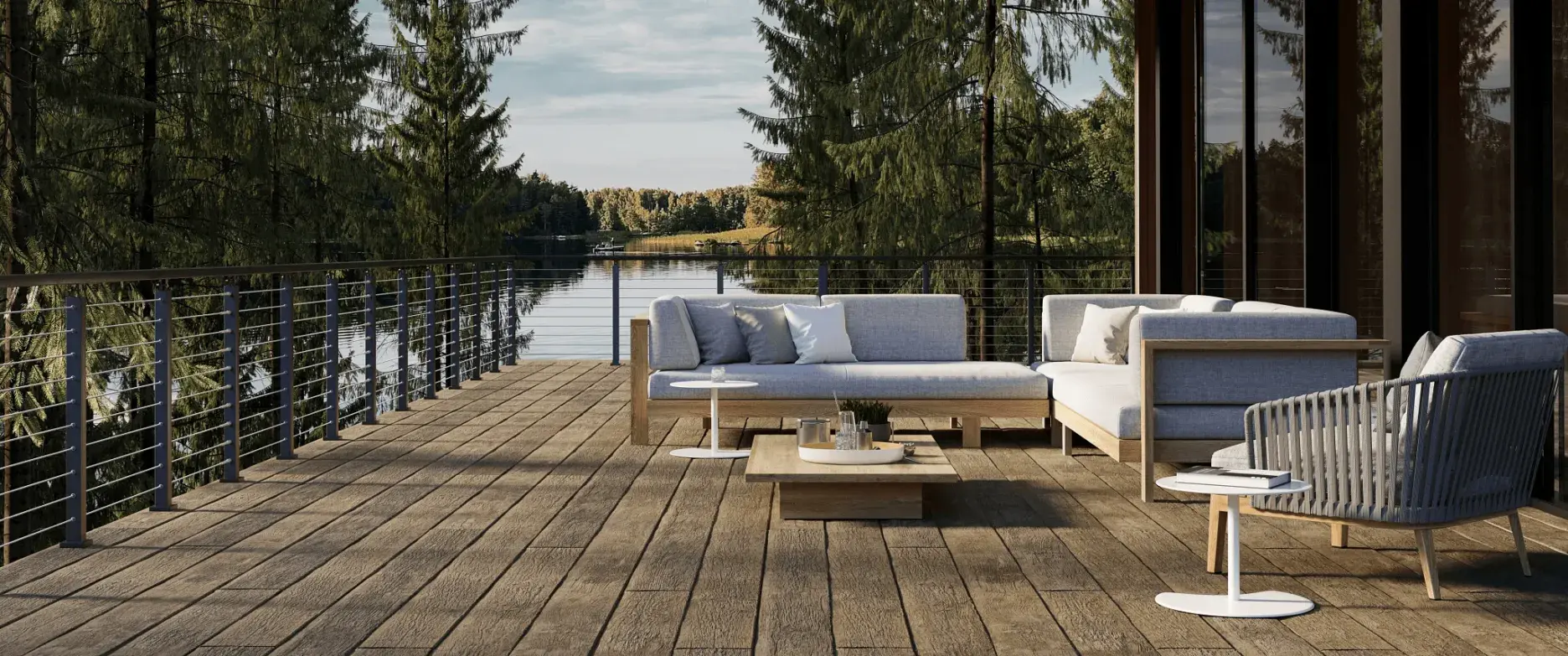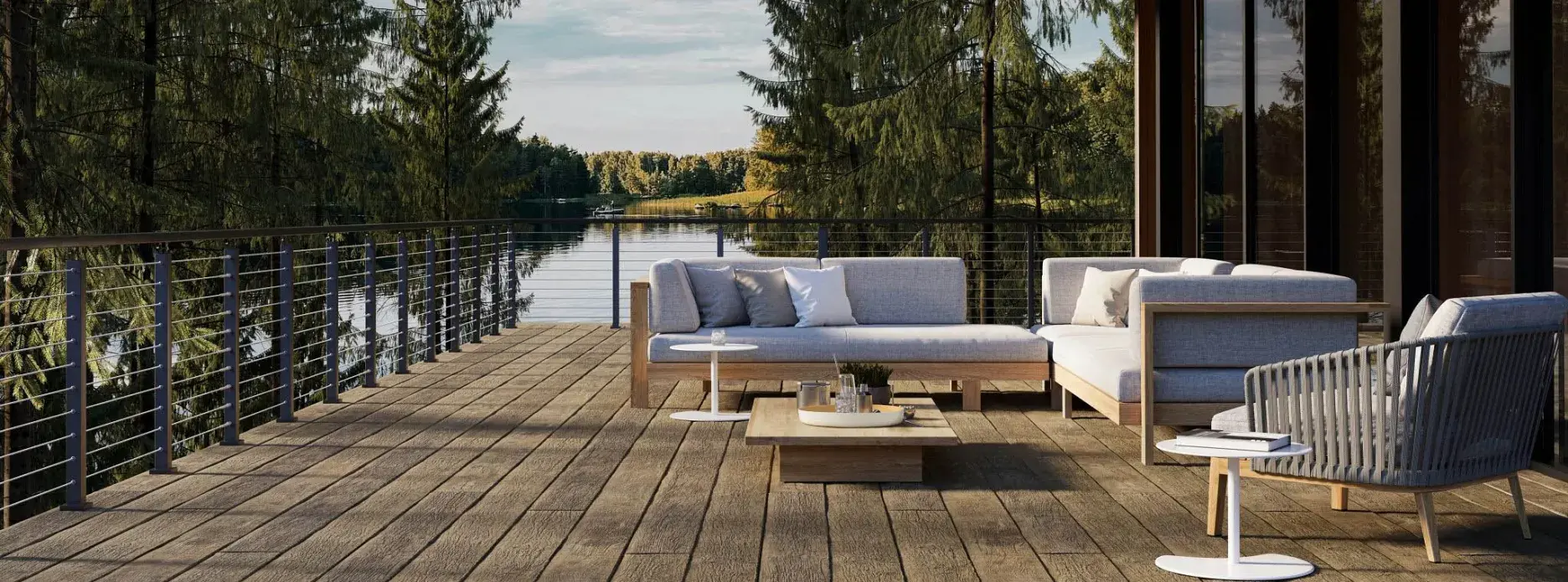MIllboard knowledgebase
Composite vs PVC decking: Choosing the right material

Article Highlights
- Popular alternatives to traditional wood decking: Although only composite decking replicates the classic wooden look without any of the natural material’s drawbacks.
- Both are manufactured materials: PVC and composite decking offers high durability and low maintenance.
- Differences between PVC and composite: Both decking materials also have several similarities, including scratch, stain, and slip resistance and long-lasting qualities.
- Composite decking is more environmentally friendly: Compared to PVC, which is made from plastic, composite decking uses renewable materials for a more sustainable choice.
- Choosing a decking material depends on your needs: Ultimately, the decision relies on your budget, aesthetic preferences, and your garden’s specifications.
Garden design trends are constantly changing, from patio tiles to deckboards. There are so many materials available that offer more than traditional landscaping materials, with both practical and aesthetic benefits. Modern manufactured products, such as composite and PVC, require less general upkeep than natural wooden decking wooden decking, and can provide perfect creative solutions for outside living spaces.
In this guide, we’ll explore the key features and benefits of composite decking and PVC, comparing them on critical factors and when the material is most suitable.
Quick Links
Composite decking offers the look of wood with the durability of plastic – find out more here.
PVC decking is made from plastic and is long-lasting – discover the material’s features.
Compare the two decking materials on cost, versatility, sustainability, and longevity features.
Discover how easy PVC and composite decking is to maintain and clean.
Find the various costs to consider before buying composite or PVC decking.
Discover the stylistic options available for the decking materials and creative ways to use them in your outdoor space.
Using the guide and the featured points, decide which decking material is right for your garden – composite vs PVC decking.
Read the most common queries on composite decking and PVC decking.
Understanding composite decking: key features and benefits
Composite decking is a modern, engineered material made from a mix of wood fibres and recycled plastic. Designed to mimic the natural beauty of wood while offering superior durability, composite materials have become popular types of decking among homeowners looking for a long-lasting solution for their outdoor space.
One of the standout features of composite decking is its resilience. Unlike traditional wood, composite decking is highly resistant to rot, warping, and insect damage. This makes it particularly well-suited for areas with varying weather conditions, where timber may deteriorate more quickly.
Composite decking is also renowned for its low maintenance, requiring no staining, sealing, or sanding – a simple clean with soap and water is often enough to keep it looking its best.
Key features:
- Long-lasting: It lasts significantly longer than traditional wood decking, reducing replacement costs.
- Durability: Resistant to rot, warping, and splintering due to its protective plastic shell.
- Eco-friendliness: Made using recycled materials, reducing waste and a greener alternative to natural wood.
- Moisture resistance: Designed to repel water and reduce the risk of decay.
- Consistent appearance: Retains its look over time without the need for staining or sealing.
Millboard composite decking
In the world of composite decking, Millboard stands out due to its unique designs and characteristics. Our decking boards are created with moulds from vintage master boards to bring the authentic wood look and feel to life. Millboard composite decking is made from a polyurethane resin core, and has a Lastane® top layer for comprehensive protection against scratches and stains.
Exploring PVC: pros and cons as a decking material
PVC decking is another engineered material, made entirely from polyvinyl chloride (a type of plastic). Like composite decking, PVC is designed to withstand the elements, offering excellent resistance to scratches, rot, and insect damage. It is often chosen for its lightweight composition and easy installation, making it a convenient option for DIY projects compared to a traditional wood deck.

Due to its moisture-resistant qualities, PVC is a good decking choice for areas near water, such as poolside or docks. The plastic material also means this decking option has a long-life span and is often easy to maintain.
Key features:
- Durability: Highly resistant to rot, mould, mildew, and insect damage, ensuring long-term performance.
- Recyclability: Some PVC decking options are recyclable, depending on the manufacturer.
- Lightweight: Easier to handle and install, making it a practical choice for many renovation projects.
- Heat and moisture resistance: Fully synthetic, non-porous and can withstand high temperatures, although it may become hot underfoot, in direct sunlight.
While highly durable, its plastic construction can make it less appealing to those seeking a natural aesthetic. Although some modern PVC boards mimic woodgrain patterns, they rarely achieve the same authenticity as composite decking.
Comparing composite and PVC decking materials
Both composite and PVC decking have some great advantages compared to traditional wood, and knowing their differences can help you make your choice. Consider the qualities you are looking for and what will be most beneficial for your outdoor space, including longevity, cost, visual appeal and the care they require.


In the table below, compare both PVC and composite decking to help your make your choice:
|
Feature |
Composite decking |
PVC decking |
|
Cost |
Moderate to high |
Moderate to high |
|
Durability |
Highly durable; resists rot, insects, and warping |
Extremely durable; good moisture resistance |
|
Eco-friendliness |
Can be made from recycled materials |
Fully synthetic; not eco-friendly |
|
Slip resistance |
Highly slip-resistance |
May be slippery due to the plastic decking; depends on the manufacturer and quality |
|
Design options |
Wide range of natural wood tones and textures |
Limited; some woodgrain options but less authentic |
|
Maintenance |
Low maintenance |
Very low maintenance |
|
Heat Retention |
Can get warm but varies by colour |
Can become very hot in direct sunlight |
|
Lifespan |
25–30+ years with proper care |
30+ years; less prone to fading |
Maintenance and cleaning: Is composite decking or PVC better?
Regarding maintenance, composite and PVC decking are relatively easy to care for compared to traditional wood. Composite decking requires occasional cleaning with a gentle soap-and-water solution or a specialised composite deck cleaner. Stains like grease or wine can be wiped away without permanent damage.
PVC decking is similarly low maintenance. Since it is non-porous, it doesn’t absorb stains and is easy to clean with hot, soapy water and a soft-bristle brush. Its resistance to mould and mildew makes it ideal for humid environments. However, scratches on PVC decking can be more visible than on composite boards, as the colour does not extend through the material.
Comparing the costs of composite and PVC decking
The cost of decking materials is an important consideration for most homeowners. Composite and PVC decking costs vary depending on brand, style, and quality. Composite decking is often seen as offering better value due to its eco-friendly performance and realistic appearance.
Over the long term, the reduced maintenance costs of both materials compared to timber can lead to significant savings.
Installation costs for both materials are generally comparable. Millboard composite decking requires certain specialist tools, fixings, and furnishings to ensure high-quality installations and guarantee longevity. We have approved installers across the country who are trained to our highest standards and are well-versed in the specific requirements needed to install Millboard composite decking and cladding panels.
Using an expert will help remove the risk of faulty installation and any future maintenance costs – find your nearest Millboard-approved installer here.
What are the design options and versatility? - Composite vs PVC decking
Both materials can create unique outdoor spaces, from multi-level decks to seamless pool surrounds. However, composite decking’s superior aesthetics and range of styles give it the edge for homeowners seeking a premium look.
PVC decking boards, while available in various colours, often falls short of mimicking the natural look of wood. However, its lighter weight makes it a practical choice for projects like rooftop decks or docks, where structural limitations might come into play.
On the other hand, composite decking is available in a broad range of colours, textures, and finishes. This allows homeowners to create practically any design in their outdoor space, from a rustic wood-like aesthetic to a sleek, modern look with darker hues.
No two Millboard decking boards offer unique patterns to further replicate the classic wood aesthetic. With subtle differences in shades and grains, our composite decks look natural and easy to mix and match with other hues.
Browse the different colours below to find your perfect shade:
For more information, read our complete Millboard guide to colour here.
Should you choose composite or PVC for your decking?
When deciding between composite and PVC decking, the right choice ultimately depends on your priorities. For homeowners seeking a natural aesthetic, eco-friendly materials, and a wide range of design options, composite decking is the clear winner. At the end of the day, its combination of durability, sustainability, and low maintenance make it a versatile and long-lasting choice.
On the other hand, PVC decking excels in environments where moisture resistance is paramount, effectively preventing mould and mildew growth. If you’re building a deck near a pool or in a particularly humid area, PVC’s non-porous surface may be worth considering despite its aesthetic limitations.
In most cases, composite decking strikes the ideal balance between performance, aesthetics, and environmental responsibility, making it the better choice to create a beautiful, functional outdoor space.
If you have any questions on your composite decking or would like more advice on flooring options, speak to the Millboard team today! Call us at 024 7643 9943.
Frequently asked questions
Is composite or PVC decking more durable in wet conditions?
While both materials are highly durable, PVC decking is entirely non-porous, making it better suited for extremely wet conditions such as poolside or coastal areas.
Can composite or PVC decking be recycled?
Composite decking is often made from recycled materials, but it is not always recyclable itself. PVC decking, while synthetic, can sometimes be recycled, depending on the manufacturer.
At Millboard, we prioritise sustainability through our innovative products and processes. Over a third of the raw materials used in manufacturing composite decking boards are recycled and reprocessed into our boards. Our sample and product packaging are also 100% recyclable.
Read more about our sustainability goals and accreditations here.









